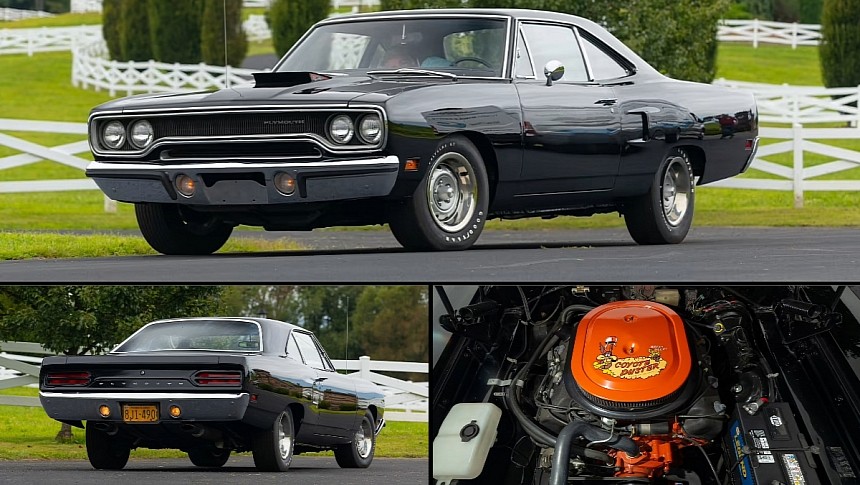Mopars from the golden muscle car era have quite a few things to brag about. They were sold with impressively potent big-block V8 engines, looked mean, and were available in several flashy High-Impact colors. Who doesn't love a Dodge in Plum Crazy, HEMI Orange, or Green Go?
I'm a big fan of Panther Pink, Sublime, and Citron Yella, but not all golden-era Mopars need to flex a High-Impact hue to stand out. B-body and E-body muscle cars look just as fetching in plain colors like red and cream, as well as metallic shades of blue and light gold. And some look downright spectacular in black. This 1970 Plymouth Road Runner is one of those cars.
And I'm saying this as a person who's never been a fan of white and black colors on vehicles of any kind. I can live with silver and grey, but white is too dull, and black is highly overrated as a paint defining performance and aggressiveness. But it's a surprisingly good option on a 1970 Road Runner. Not only does it highlight the car's "coke bottle" design, but it also gives it an unexpectedly elegant appearance. It almost turns it into a GTX, the more upscale version dubbed "the gentleman's muscle car."
The black theme continues inside, with everything from the door panels and seats to the dashboard and headliner wrapped in Plymouth's darkest option that year. And since this Road Runner doesn't have a vinyl top, it's pretty much a triple black muscle car, a combo that's likely extremely rare. But did it leave the factory like this?
Well, the coupe was restored at some point, but it was ordered in Black Velvet. And even though it was repainted, it still has all its original body panels. The interior is also factory-correct and includes options like bucket seats, a fold-down center armrest, and a pistol-grip Hurst shifter.
There's even better news under the hood. Not only does it hide a numbers-matching powerplant, but this Road Runner is one of those rare cars that left the assembly line with a 426-cubic-inch (7.0-liter) HEMI V8. Rated at 425 horsepower when new, the "Coyote Duster" mill makes it one of only 152 vehicles optioned up with the range-topping HEMI in 1970. To put this into perspective, only 0.4% of all Road Runners sold that year got the mighty 426. Rare doesn't even begin to cover it.
And that's if we include all body styles and transmission options. This rig becomes even scarcer if we go into specifics. Of the 152 HEMI examples, 75 were hardtops, 74 coupes (post cars), and three convertibles. This one's a coupe, identified by the "RM21" sequence in the VIN, so it's one of only 74 units made. The four-speed gearbox narrows it down even more to just 44 cars. The triple-black layout likely makes it a one-of-one gem, but this bit of info is difficult to confirm.
A two-owner car, the Road Runner shows only 11,229 miles (18,071 km) on the clock. There's no word on whether that's the actual mileage or not, but this Mopar sure looks like it spent a lot of time in storage. It's probably worth six figures, too, but we'll learn more about that when it goes under the hammer at the Kissimmee Auction in January 2024.
And I'm saying this as a person who's never been a fan of white and black colors on vehicles of any kind. I can live with silver and grey, but white is too dull, and black is highly overrated as a paint defining performance and aggressiveness. But it's a surprisingly good option on a 1970 Road Runner. Not only does it highlight the car's "coke bottle" design, but it also gives it an unexpectedly elegant appearance. It almost turns it into a GTX, the more upscale version dubbed "the gentleman's muscle car."
The black theme continues inside, with everything from the door panels and seats to the dashboard and headliner wrapped in Plymouth's darkest option that year. And since this Road Runner doesn't have a vinyl top, it's pretty much a triple black muscle car, a combo that's likely extremely rare. But did it leave the factory like this?
Well, the coupe was restored at some point, but it was ordered in Black Velvet. And even though it was repainted, it still has all its original body panels. The interior is also factory-correct and includes options like bucket seats, a fold-down center armrest, and a pistol-grip Hurst shifter.
There's even better news under the hood. Not only does it hide a numbers-matching powerplant, but this Road Runner is one of those rare cars that left the assembly line with a 426-cubic-inch (7.0-liter) HEMI V8. Rated at 425 horsepower when new, the "Coyote Duster" mill makes it one of only 152 vehicles optioned up with the range-topping HEMI in 1970. To put this into perspective, only 0.4% of all Road Runners sold that year got the mighty 426. Rare doesn't even begin to cover it.
And that's if we include all body styles and transmission options. This rig becomes even scarcer if we go into specifics. Of the 152 HEMI examples, 75 were hardtops, 74 coupes (post cars), and three convertibles. This one's a coupe, identified by the "RM21" sequence in the VIN, so it's one of only 74 units made. The four-speed gearbox narrows it down even more to just 44 cars. The triple-black layout likely makes it a one-of-one gem, but this bit of info is difficult to confirm.
A two-owner car, the Road Runner shows only 11,229 miles (18,071 km) on the clock. There's no word on whether that's the actual mileage or not, but this Mopar sure looks like it spent a lot of time in storage. It's probably worth six figures, too, but we'll learn more about that when it goes under the hammer at the Kissimmee Auction in January 2024.











